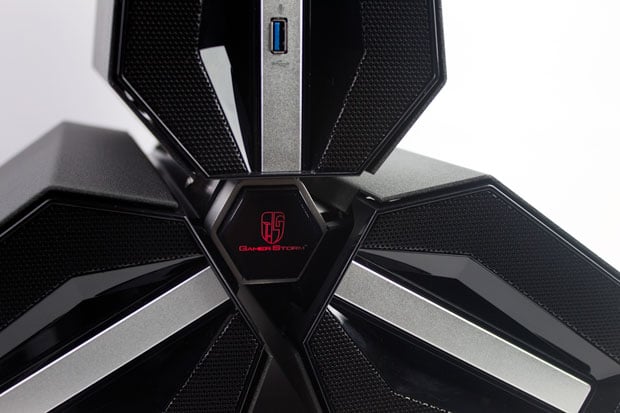CyberPower Trinity Xtreme Gaming PC Review: 'Unique' Is An Understatement
The Trinity Design and Layout
The gaming PC market is flooded with outrageous, LED-laden cases that are meant to stand out, but the CyberPower Trinity Xtreme manages to be one of the more eye-catching systems we’ve ever seen – and it has hardly any lighting at all. The blades and its sheer size (about 18.3 inches wide by 15.55 inches deep and 15.27 inches high) make the Trinity the center of attention.
The back of the Trinity has all of the ports you’d expect, including plenty of USB 3.0 ports, an eSATA port, two Gigabit Ethernet ports and the HDMI and DP ports on the GTX Titan X. As unusual as the computer’s design is, it makes for a very clean system.
The PC is divided into three blades, known as the performance, storage, and CPU blades. In the center is what CyberPower calls the “spine,” a hexagonal steel structure that holds the cables passing from one blade to the next. The setup is very sturdy and CyberPower says that the Trinity can even be stood on a single blade if one so chooses. I tried this and found it to be reasonably sturdy this way, but I doubt many Trinity owners will like that approach. It feels much more solid resting on two blades.
Getting into a blade is a matter of removing two thumbscrews and then sliding off the blade shell. Because the whole shell comes off, you can reach into the blade from almost any angle, which means that upgrading the graphics card and other parts should be reasonably simple.
The performance blade houses the Nvidia GeForce GTX Titan X graphics card, along with as many as three SSDs. This blade is air-cooled, thanks to the Titan’s own fan and another fan at the front.
The storage blade houses any hard drives (there are slots for up to three drives) and the power supply. This blade is fairly cramped, but CyberPower does a nice job of routing the cables up into the Trinity’s spine.
The CPU blade is also full (though not cramped), thanks to the liquid cooling system CyberPower installs. The layout in this blade is particularly upgrade friendly, as the ASRock X99E-ITX/AC motherboard puts the memory right down by the edge of the blade, in easy reach.
The cooling system is an Asetek 550LC that cools the Trinity’s Intel Core i7-5820K processor. The 120mm radiator sits next to the motherboard, where its fan has plenty of room. Cabling in this blade (as well as the other blades) is out of the way, thanks to the Trinity’s spine. All told, despite the unusual shape of each blade, they're mostly clutter free and easy to access. The design of this chassis was well thought out.
Aside from the power button and some USB and headphone ports, the front of the system is remarkably clutter free. The power button is also the system’s only exterior light, glowing red while the Trinity is powered on. The system doesn’t have an optical drive, which shouldn’t be an issue for most gamers these days, but the lack of a built-in in media card reader is annoying. If you need a way to plug in your SD card, you’ll have to add the external USB card reader for $11 during the configuration or buy one separately.
The back of the Trinity has all of the ports you’d expect, including plenty of USB 3.0 ports, an eSATA port, two Gigabit Ethernet ports and the HDMI and DP ports on the GTX Titan X. As unusual as the computer’s design is, it makes for a very clean system.
The PC is divided into three blades, known as the performance, storage, and CPU blades. In the center is what CyberPower calls the “spine,” a hexagonal steel structure that holds the cables passing from one blade to the next. The setup is very sturdy and CyberPower says that the Trinity can even be stood on a single blade if one so chooses. I tried this and found it to be reasonably sturdy this way, but I doubt many Trinity owners will like that approach. It feels much more solid resting on two blades.
Getting into a blade is a matter of removing two thumbscrews and then sliding off the blade shell. Because the whole shell comes off, you can reach into the blade from almost any angle, which means that upgrading the graphics card and other parts should be reasonably simple.
The performance blade houses the Nvidia GeForce GTX Titan X graphics card, along with as many as three SSDs. This blade is air-cooled, thanks to the Titan’s own fan and another fan at the front.
The storage blade houses any hard drives (there are slots for up to three drives) and the power supply. This blade is fairly cramped, but CyberPower does a nice job of routing the cables up into the Trinity’s spine.
The CPU blade is also full (though not cramped), thanks to the liquid cooling system CyberPower installs. The layout in this blade is particularly upgrade friendly, as the ASRock X99E-ITX/AC motherboard puts the memory right down by the edge of the blade, in easy reach.
The cooling system is an Asetek 550LC that cools the Trinity’s Intel Core i7-5820K processor. The 120mm radiator sits next to the motherboard, where its fan has plenty of room. Cabling in this blade (as well as the other blades) is out of the way, thanks to the Trinity’s spine. All told, despite the unusual shape of each blade, they're mostly clutter free and easy to access. The design of this chassis was well thought out.














